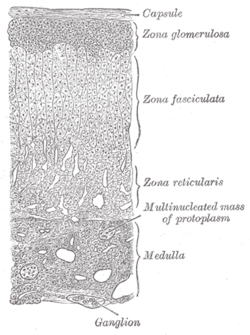Adrenal cortex
| Adrenal cortex | |
|---|---|

Layers of cortex.
|
|

The adrenal cortex
|
|
| Details | |
| Precursor | mesoderm |
| Identifiers | |
| Latin | cortex glandulae suprarenalis |
| Dorlands /Elsevier |
c_57/12261690 |
| TA | A11.5.00.007 |
| FMA | 15632 |
|
Anatomical terminology
[]
|
|
Situated along the perimeter of the adrenal gland, the adrenal cortex mediates the stress response through the production of mineralocorticoids and glucocorticoids, such as aldosterone and cortisol, respectively. It is also a secondary site of androgen synthesis. Recent data suggest that adrenocortical cells under pathological as well as under physiological conditions show neuroendocrine properties; within the normal adrenal, this neuroendocrine differentiation seems to be restricted to cells of the zona glomerulosa and might be important for an regulation of adrenocortical function.
The adrenal cortex comprises three main zones, or layers. This anatomic zonation can be appreciated at the microscopic level, where each zone can be recognized and distinguished from one another based on structural and anatomic characteristics. The adrenal cortex exhibits functional zonation as well: by virtue of the characteristic enzymes present in each zone, the zones produce and secrete distinct hormones.
All adrenocortical steroid hormones are synthesized from cholesterol. Cholesterol is transported into the adrenal gland. The steps up to this point occur in many steroid-producing tissues. Subsequent steps to generate aldosterone and cortisol, however, primarily occur in the adrenal cortex:
The upper (multi-colored) adrenocortical steroid pathway illustration at right has an error. It is not aromatase which converts estrone to estradiol, it is 17-hydroxysteroid dehydrogenase (see adjacent, parallel, orange pathway) which converts estrone to estradiol. If somebody knows how to get this fixed, please do so.
The adrenal cortex produces a number of different corticosteroid hormones.
The primary mineralocorticoid, aldosterone, is produced in the adrenocortical zona glomerulosa by the action of the enzyme aldosterone synthase (also known as CYP11B2). Aldosterone is largely responsible for the long-term regulation of blood pressure. Aldosterone effects on the distal convoluted tubule and collecting duct of the kidney where it causes increased reabsorption of sodium and increased excretion of both potassium (by principal cells) and hydrogen ions (by intercalated cells of the collecting duct). Sodium retention is also a response of the distal colon, and sweat glands to aldosterone receptor stimulation. Although sustained production of aldosterone requires persistent calcium entry through low-voltage activated Ca2+ channels, isolated zona glomerulosa cells are considered nonexcitable, with recorded membrane voltages that are too hyperpolarized to permit Ca2+ channels entry. However, mouse zona glomerulosa cells within adrenal slices spontaneously generate membrane potential oscillations of low periodicity; this innate electrical excitability of zona glomerulosa cells provides a platform for the production of a recurrent Ca2+ channels signal that can be controlled by angiotensin II and extracellular potassium, the 2 major regulators of aldosterone production. Angiotensin II originates from plasmatic angiotensin I after the conversion of angiotensinogen by renin produced by the juxtaglomerular cells of the kidney.
...
Wikipedia
